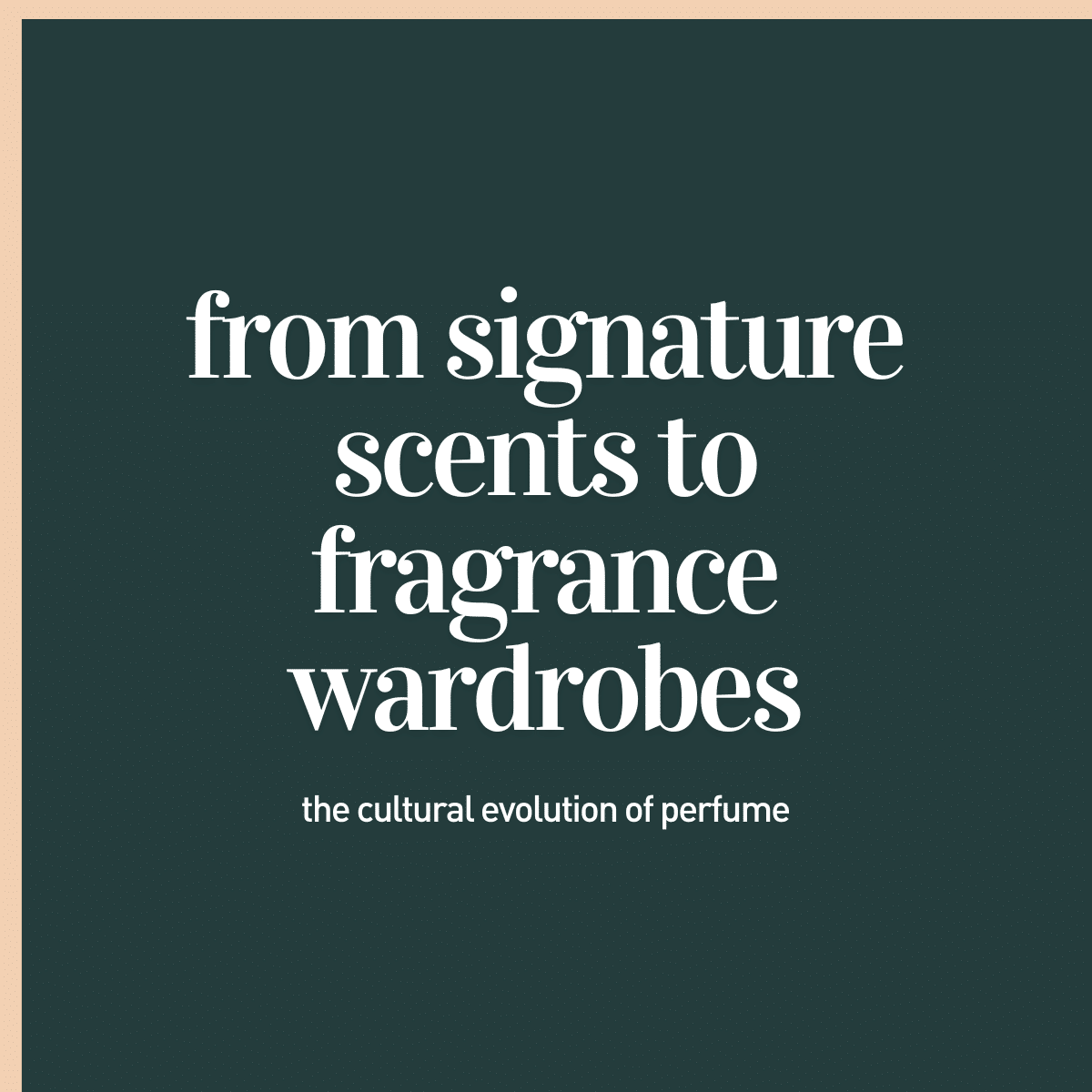
From signature scents to fragrance wardrobes
Perfume is more than just a fragrance—it’s a statement, a memory, and for many, an extension of identity. Across cultures, how we wear perfume is deeply connected to our traditions, lifestyles, and even our sense of self.
As a communications experts with a deep interest in cultural patterns, we’ve always been fascinated by how scent serves as an unspoken language, a sensory signature that carries cultural weight. This is particularly evident when comparing the French and Middle Eastern approaches to fragrance.
French perfumery has long championed the idea of a signature scent—a fragrance so intertwined with one’s personality that it becomes almost inseparable. In contrast, the Middle Eastern tradition embraces olfactory layering, where scent is chosen based on mood, occasion, and environment.
Today, the global perfume market is shifting. The rise of niche fragrances, personalized fragrance wardrobes, and social media-driven discovery is reshaping the industry, allowing consumers to break away from conventional perfume habits.
The French approach: the concept of a signature scent
A legacy of elegance and consistency
French perfumery is synonymous with luxury, craftsmanship, and timeless sophistication. Historically, French fragrance houses like Chanel, Guerlain, and Dior have shaped the industry with their iconic scents, reinforcing the notion that a great perfume should be a lifelong companion rather than a passing trend.
The idea of a signature scent is deeply rooted in French culture. Much like personal style, fragrance is viewed as an extension of one’s identity—a scent chosen carefully and worn consistently to leave a lasting impression. The French approach to perfume is about elegance, subtlety, and restraint. Rather than switching fragrances frequently, many prefer to invest in a single scent that becomes part of their daily ritual and personal brand.
Scent as identity
In France, the relationship between a person and their fragrance is intimate. The right scent is meant to blend seamlessly with one’s natural body chemistry, becoming so familiar that it almost goes unnoticed by the wearer but is deeply associated with them by others.
However, this classic approach is gradually being challenged. As younger generations embrace personalization, they are moving toward fragrance wardrobes, taking inspiration from Middle Eastern traditions where fragrance is more fluid and expressive.
The Middle Eastern perspective: a library of scents
A rich olfactory tradition
Middle Eastern perfumery is an art form with deep historical and cultural roots. Unlike the French signature scent approach, Middle Eastern fragrance traditions celebrate variety, complexity, and layering.
Fragrance is deeply embedded in daily life, social rituals, and religious practices. The use of oud, bakhoor, amber, and attars has been a staple for centuries. Perfume is not just an accessory; it is a way to mark status, express emotions, and create an aura of presence.
Matching scent to mood and occasion
Middle Eastern consumers often have a library of scents, choosing different perfumes based on the occasion, the season, or even their mood. The art of fragrance layering (mukhallat) is a sophisticated practice where multiple scents—oils, sprays, and incense—are combined to create a distinctive, long-lasting composition.
This ritual is deeply ingrained in Middle Eastern culture, where personal scent is considered an essential part of one’s presence. The fragrance layering trend is now spreading globally, influencing Western brands and consumers who are seeking more customized olfactory experiences.
The global shift: the rise of niche perfumes
Breaking away from tradition
Over the past decade, the fragrance market has seen a shift from mass-market scents to niche, artisanal perfumes. According to Future Business Insights, the global niche perfume market is valued at around $3 billion and is projected to reach $7.4 billion by 2031.
Niche brands like Ex Nihilo, Byredo, and D.S. & Durga have built their reputations by offering unique, daring compositions that prioritize craftsmanship and high-quality ingredients over celebrity endorsements. Consumers are moving away from heavily marketed designer fragrances, seeking instead scents that feel personal and exclusive.
This shift aligns with the broader cultural transition from one-signature-scent loyalty to fragrance wardrobes, where individuals select different fragrances based on mood, outfit, or event—much like Middle Eastern traditions.
The role of social media
Social media has transformed how fragrances are discovered, experienced, and marketed, making virtual launches as impactful as in-store ones. Platforms like TikTok, Instagram, and YouTube use immersive visuals, cinematic storytelling, and influencer endorsements to bring scents to life. Through teaser posts, countdowns, and live-streamed unboxings, brands generate excitement, while hashtags and challenges encourage user engagement. The rise of blind buys, driven by influencer testimonials and fragrance communities, has made it common for consumers to purchase perfumes without ever smelling them.
Influencers play a key role in this shift, translating scents into relatable narratives through personal anecdotes, fragrance wardrobe selections, and first-impression videos. Their endorsements, often paired with exclusive discounts, drive sales and make niche and luxury perfumes more accessible. Meanwhile, AI-powered scent-matching tools, virtual try-ons, and subscription sample services bridge the gap between digital engagement and physical experience, allowing consumers to explore fragrances in a more interactive way.
Beyond marketing, social media fosters community-driven fragrance culture. Brands create fragrance clubs and discussion forums where enthusiasts exchange scent-layering tips and share user-generated content. This digital-first approach has turned perfume into more than just a product—it’s now a personality statement, an aesthetic, and a lifestyle choice, shaping the future of the fragrance industry.
The impact of niche brands
Independent fragrance houses are thriving, thanks to their ability to tell compelling stories, offer customization, and engage directly with consumers. The French brand Ex Nihilo, for example, uses an Osmologue machine to allow customers to create bespoke perfumes in-store, a trend that aligns perfectly with Middle Eastern scent traditions. The demand for exclusivity has also led to an increase in high-end fragrance boutiques and limited-edition releases. For example, Amouage, an Omani perfume house, has successfully expanded beyond the Middle East, leveraging its heritage and luxury craftsmanship to attract global consumers.
Beyond exclusivity, niche brands have transformed how consumers engage with perfume. Unlike mass-market scents, which rely on broad appeal, niche fragrances emphasize rare ingredients, bold compositions, and creative narratives that resonate with fragrance connoisseurs. This approach has positioned independent perfumers as innovators, challenging traditional luxury houses to rethink their strategies.
Social media has played a crucial role in this shift, democratizing perfume discovery and amplifying niche brands’ reach. Platforms like TikTok and Instagram have turned once-obscure brands into viral sensations, with influencers and fragrance enthusiasts driving demand for unique, lesser-known scents. As a result, niche perfumery is no longer just for experts—it has become a cultural phenomenon that redefines personal expression through scent.
Business implications
Cultural insights for the fragrance Industry
Understanding cultural nuances is crucial for fragrance brands aiming to expand their global reach. In a world where personalization is becoming a key driver of consumer preferences, customizable fragrances are no longer a luxury but an expectation. The growing demand for bespoke scents, exemplified by Ex Nihilo’s Osmologue and Amouage’s tailored fragrance experiences, highlights how brands must adapt to offer more individualized options. This shift aligns with the Middle Eastern approach to perfumery, where layering and personal scent curation have long been an art form.
Additionally, digital influence has become indispensable. The rise of PerfumeTok and fragrance communities on social media underscores the need for brands to engage consumers through compelling storytelling and interactive experiences. Viral marketing, influencer partnerships, and user-generated content are shaping perfume trends in real-time, allowing niche and heritage brands alike to build global followings. At the same time, data-driven customization—where AI and scent profiling tools recommend fragrances based on consumer preferences—is redefining how perfumes are discovered and marketed.
As the Middle Eastern perfume market is projected to reach $5.4 billion by 2032, brands must rethink their strategies beyond traditional Western markets. This expansion requires a keen understanding of regional preferences, favoring bold, long-lasting, and customizable scents over mass-market formulations. Successfully bridging these cultural differences will be the key to thriving in an increasingly diverse and discerning fragrance landscape.
The future of perfumery
As fragrance traditions blend across cultures, we are entering an era where perfume is no longer just a static accessory but an evolving form of self-expression. The future of perfumery lies in hybrid models—combining the refinement of French perfumery with the creativity and personalization of Middle Eastern scent traditions. This fusion is already evident in the rise of niche brands that prioritize both craftsmanship and consumer involvement in scent creation.
Innovation in formulation and application will also shape the industry’s future. With advancements in scent layering, AI-driven fragrance curation, and sustainable ingredient sourcing, perfumes will become more adaptable to individual preferences and lifestyles. We can expect to see more hybrid olfactory compositions that push the boundaries between classic and contemporary perfumery—scents that evolve throughout the day, respond to body chemistry, or even change with temperature and humidity.
Ultimately, the next chapter of perfumery will be defined by inclusivity, technology, and deep cultural appreciation. As global consumers seek more than just a bottle of perfume, brands that embrace multi-sensory storytelling, customization, and heritage-driven innovation will shape the industry’s future.
The evolution of perfume culture—from the French signature scent to the Middle Eastern fragrances wardrobes—reflects a broader shift in how we perceive identity and luxury. No longer confined to rigid traditions, perfume is becoming more personal, more diverse, and more experimental.
For brands, this means embracing cultural insights, personalization, and digital engagement to stay relevant in an increasingly niche-driven market. As someone immersed in communication and branding, it’s fascinating to see how perfume—an invisible yet powerful element—continues to shape and be shaped by cultural narratives worldwide.
Whether we choose one signature scent or an entire wardrobe of fragrances, one thing is certain: perfume will always be more than just a scent—it’s a story, a statement, and a bridge between cultures.






Leave a comment: